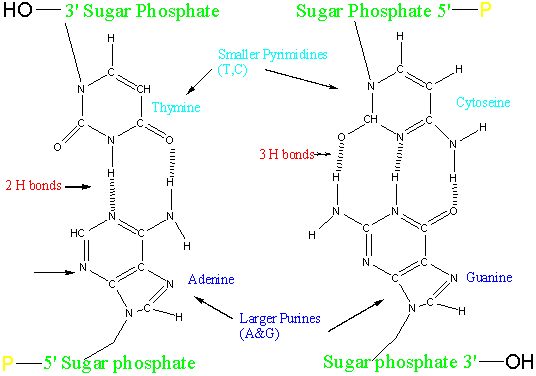See also chromosomes
Materials:
DNA Extraction: Wizard Genomic DNA purificaiton kit (Promega, A2361). (Kamimura, US Patent Application No: 16/484,061, published as US 2019/0359691)
PCR Product Purification: QIAquick PCR purificaiton kit (Qiagen, 28106); QIAquick Gel Extraction Kit (Qiagen, 28706).
Measurement of purified DNA: Quant-iT Pico Green dsDNA Assay kit (ThermoFisher scientific, P7589)
DNA sequencing: GS Junio Titanium Sequencing Kit (Roche, Cat. No. 05 996 554 001); GS Junio Titanium PicoTiterPlat Kit (Roche, Cat. No. 996 619 001).
DNA Structure:
- 2 long polynucleotide chains composed of four types of nucleotides. A nucleotide is composed of a 5 carbon sugar, a phosphate group and a nitrogenous base (of which there are 4 types). The sugar in DNA is deoxyribose (a ribose sugar without an O attached to the H on the #2 carbon sugar). The term “nucleoside” is sometimes used to simply refer to the sugar and nitrogenous base without the phosphate group.
-
Each strand of DNA contains a sequence of nucleotides that is exactly complementary to the nucleotide sequence of its partner strand. During DNA replication as when a cell divides, each such complementary strand will serve as a template for a new strand.
-
the 2 polynucleotide strands run in opposite direction; they are anti-parallel in that one strand runs from 5′ to 3′ while the opposite strands runs in the 3′ to 5′ direction.
-
the DNA strands do not exist in a straight line, but rather rap around each other to form a “double helix”. Each turn of DNA on this double helix makes up 10.4 nucleotide pairs. This coiling also creates 2 grooves; a wider major groove and a smaller minor groove. Grooves facilitate interactions of proteins and DNA through H bonding.
-
The nucleotides are covalently linked together in the chain through the sugars and phosphates (i.e., alternating sugar-phosphate-sugar-phosphate) which forms the outside or “backbone” of the chain.
-
the 5′ end of each polynucleotide strand carries an unlinked phosphate group attached to the 5′ position on the sugar ring and, the 3′ end of each strand carries a free hydroxyl (-OH) group attached to the 3′ position on the sugar ring.
-
the nitrogenous bases are stacked like pennies pointing toward the center of the helix and the 2 strands are held together by hydrogen bonding between the bases; adenine (A) pairs with thymine (T) which forms 2 H bonds and guanine (G) pairs with cytosine (C) which forms 3 H bonds.
-
-
because purines (A or G) are larger bases than pyrimidines (T or C), all base pairs are the same size which gives the DNA molecule its uniform size
-
The N-9 of a purine and N-1 of a pyrimidine is attached to the C-1 of deoxyribose

-

